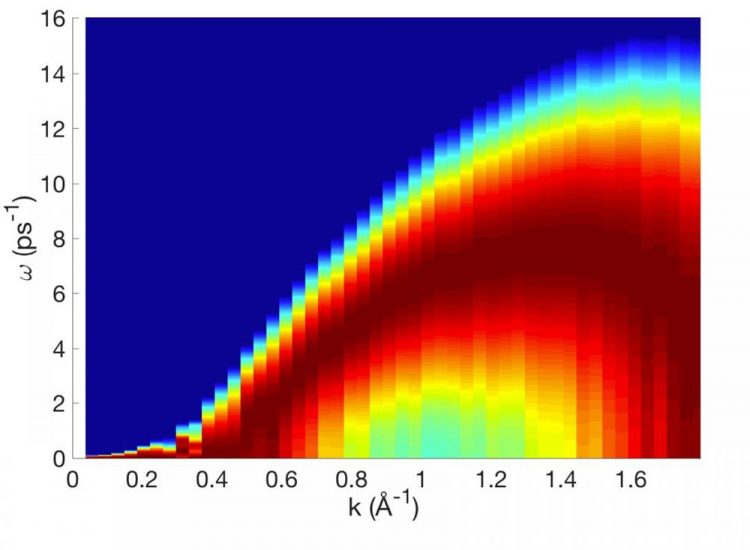Mind the liquid gap: Liquids are capable of supporting waves with short wavelengths only

Emergence of the gap in the liquid wave spectrum seen as the absence of the signal in the low range of k-points. Credit: Kostya Trachenko
Liquids are the least understood state of matter and for a long time it has been believed that they can sustain both gas-like waves with long wavelengths and solid-like waves with short wavelengths, but it wasn't clear just how solid-like waves propagate in liquids.
The researchers found that a gap emerges in the liquid wave spectrum. This gap implies that only short-wavelength solid-like waves can propagate. This understanding will allow researchers to develop the theory of the liquid state and opens new avenues of research into liquids.
Using the predictions from their recent theory, the researchers have performed an extensive modelling study to ascertain the gap and discuss its properties in the journal Physical Review Letters.
Lead author Dr Kostya Trachenko said: “This result is important for the fundamental understanding of liquids and gives us hope that we are getting close to constructing a consistent theory of this elusive third state of matter. We have good theories of waves in solids and gases but, surprisingly and despite many decades of research, not in liquids.”
He added: “The difference between liquids and solids is that particles rearrange in liquids with a certain frequency – this enables liquids to flow. These rearrangements disrupt the propagating waves but they do so in an interesting way. You can think about these motions as microscopic demons living in the liquid which eat all long-wavelength solid-like waves but leave short-wavelength waves intact. In other words, flowing liquid particles act as wave filters which is an insight not hitherto anticipated.”
The results are also important for widening and optimising industrial processes where supercritical fluids have started to be widely deployed including in cleaning, extracting and environmental applications.
Media Contact
All latest news from the category: Physics and Astronomy
This area deals with the fundamental laws and building blocks of nature and how they interact, the properties and the behavior of matter, and research into space and time and their structures.
innovations-report provides in-depth reports and articles on subjects such as astrophysics, laser technologies, nuclear, quantum, particle and solid-state physics, nanotechnologies, planetary research and findings (Mars, Venus) and developments related to the Hubble Telescope.
Newest articles

High-energy-density aqueous battery based on halogen multi-electron transfer
Traditional non-aqueous lithium-ion batteries have a high energy density, but their safety is compromised due to the flammable organic electrolytes they utilize. Aqueous batteries use water as the solvent for…

First-ever combined heart pump and pig kidney transplant
…gives new hope to patient with terminal illness. Surgeons at NYU Langone Health performed the first-ever combined mechanical heart pump and gene-edited pig kidney transplant surgery in a 54-year-old woman…

Biophysics: Testing how well biomarkers work
LMU researchers have developed a method to determine how reliably target proteins can be labeled using super-resolution fluorescence microscopy. Modern microscopy techniques make it possible to examine the inner workings…





















